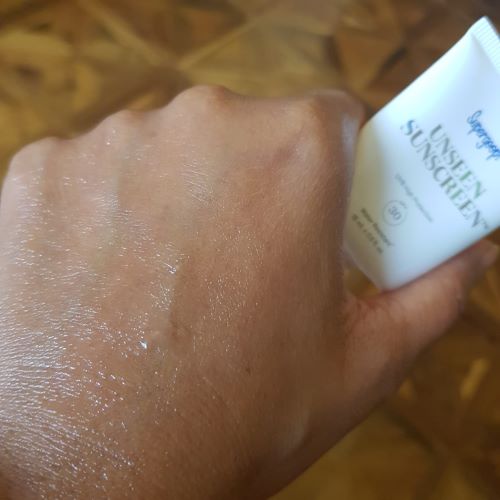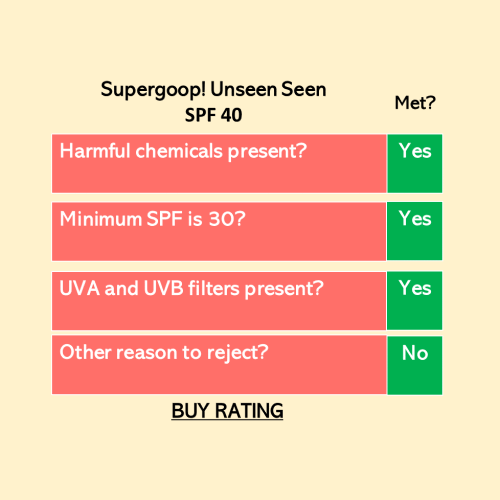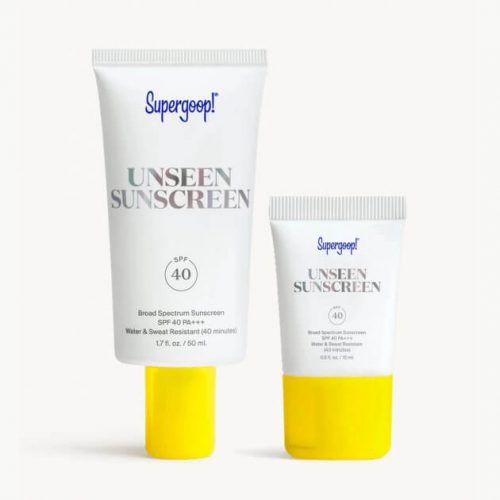This brand is not to be confused with goop! (Gywenth Paltrow’s baby), as Supergoop! makes sunscreens.
The brand’s ethos is transparency and it gives consumers more information about its products than other comparable brands do. For example, this sunscreen has an SPF lab test report on its page. Here is the link. This is the first time I have seen a brand make this publicly available in the USA and its really encouraging.
The consistency of the sunscreen
This is the SPF 30 unseen sunscreen that I bought. Its consistency is like vaseline, if it were in a gel form.
The beauty of the product is it spreads with no white cast. On my face it doesn’t fee heavy or as if there is an occlusive (or vaseline like layer). Its as if the sunscreen is playing a mind game. It looks one way, but behaves differently to your expectations.
This sunscreen does reapply relatively well, but its not super-comfortable in the summer. It feels as if your skin is less breathable (if you know what I mean) because of the occlusive layer.


What damages are sunscreens trying to protect us against?

Happy Skin Days sunscreen test

This is at least an SPF 30 product. It contains both filters protecting against UVA and UVB radiation and has none of the harmful chemicals that I look for (parabens, Oxybenzone, BHT.
There is no reason to not use this product on paper and its not a bad option for an American sunscreen.
The filters
This SPF 40 product has had its formula revised and you can see the effect of the revised formulas as below:

Both formulas contain Avobenzone (at 3%) and differing amounts of Octocrylene.
The yellow dotted line is what you should pay attention to: it shows the absorption profile of the sunscreen when its irradiated with 1MED of UV radiation.
With the old formulation the yellow dotted line is closer to the yellow solid line and therefore, the sunscreen in the sunlight offers good absorption of UVA radiation.
With the new formula, there is a bigger gap between the yellow line and its dotted counterpart. This means that the product offers less protection in the UVA region, EVEN THOUGH THE YELLOW SOLID LINE IS HIGHER….
I am not surprised.
The primary UVA filter is Avobenzone that is notoriously photounstable. It can lose between 50%-90% of its efficacy within 60 minutes of exposure to sunlight. Therefore, its usually combined with a photostabiliser, such as Octocrylene. Clearly Octocrylene at 10% (OLD formulation) is more effective at stabilising Avobenzone then Octocrylene at 4% (NEW formulation).
Would I buy this new product?
Clearly the revised sunscreen does not offer the UVA protection it used to BUT this is not a reason to stop buying the product.
A major plus point is that this sunscreen blends well. It does not leave a white cast that many American sunscreens do. Therefore, I would still be okay using it. However, if you live in the EU, remember that there are better sunscreens available because EU law permits new style filters that are not permitted for use in American sunscreens.
Available for sale in the USA at USD 34 for 50ml.
You may also be interested in:
- What damage is sunscreen trying to prevent?
- Why you should read the ingredient label of American sunscreens (A blog explaining the difference in American and European sunscreens)
- Myths about sunscreen protection
- What is PA++++? (A blog explaining sunscreen protection against UVA radiation)
HAPPY SKIN DAYS. COPYRIGHT RESERVED 2021. I am a non-affiliated skincare blogger. I invest my own resources in researching and creating content for my blog. The contents of this blog, including images are protected by copyright law(s). My content cannot be replicated without my consent. You can write to me at email@happyskindays.com. I will file criminal and civil charges for copyright infringement.
